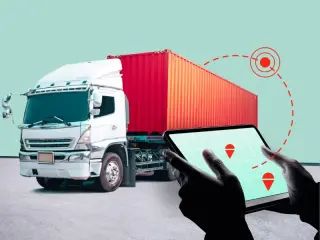
Telematics technology is revolutionising how businesses monitor and manage their fleet vehicles. By combining telecommunications, GPS, and data analytics, telematics enables real-time tracking and examines driver behaviour.
However, the legal implications of telematics must be considered. This includes data privacy, surveillance, and consent. Understanding the law and telematics is critical to ensure you maximise the benefits and comply with legal regulations.
What is a vehicle tracking system?
A vehicle tracking system, or telematics, uses GPS (Global Positioning System) technology to monitor and manage the location and movement of vehicles. It’s also used to assess the behaviour of drivers and identify areas of improvement to maximise efficiency.
Vehicle tracking systems transmit data to a central server which receives, processes, and stores the tracking data which can then be used to generate reports.
Businesses often use vehicle tracking systems as they offer many benefits. These include:
Improved fleet efficiency
Improved safety
Reduced costs
Optimisation of routes
Reduced emissions
If you want to learn more about the future of telematics, our guide delves into this.
What vehicles can be tracked in the UK?
You can track most vehicles in the UK, as long as you have the consent of your drivers and ensure the proper use of data under GDPR. This includes company cars, HGVs and even specialist vehicles. However, there are additional regulations for HGV drivers, who must use tachographs to track the time spent driving.
You might use different tracking systems depending on the vehicle used. For example, you can use geofencing to set virtual boundaries for goods vehicles and then you’ll receive an alert if they leave this area. This prevents unauthorised use and allows you to locate stolen vehicles quickly.
Is GPS tracking legal?
GPS tracking is legal in the UK but it’s subject to specific laws and regulations to protect privacy and ensure responsible use. The key legal frameworks for GPS tracking include:
GDPR and Data Protection Act (DPA)
Tracking a vehicle always requires consent. Your drivers must understand how and why their data is being used.
To track vehicles, there must be a legitimate business need, such as fleet management, and ensure data is only used for that purpose.
Personal data collected through tracking systems must be securely stored and not shared with unauthorised parties.
Employment Practices Code
The Employment Practices Code guides businesses on how to handle their employees’ data responsibly and lawfully.
Vehicle monitoring should not be excessively intrusive but in proportion to the business need. You should balance your business interests with your employees' right to privacy.
Human Rights 1998
The Human Rights Act protects employee privacy rights, so GPS tracking must not infringe on an individual's right to privacy, particularly when vehicles are used for personal purposes.
You must therefore ensure that vehicle tracking is limited to commercial activities and not used during personal time unless explicitly agreed upon.
Consent and transparency
If you decide to implement a telematics system, you must inform your employees that their work vehicles will be monitored. They should understand what data will be collected, such as location, speed, driving habits, and how it will be used.
Being transparent about when tracking will occur is important if the vehicle is used for both work and personal purposes. This ensures you have complete consent from your drivers.
Data collection, usage, and storage
Telematics systems can collect various types of data to provide valuable insights into vehicle performance, driver behaviour, and operational efficiency. Some of the key types of data collected by telematics include:
Vehicle location: GPS data is used to track the real-time location of vehicles, enabling fleet managers to monitor routes, optimise dispatching, and improve overall logistics.
Vehicle diagnostics: telematics systems can gather data on engine performance, fuel consumption, mileage, and other diagnostic information to enable proactive maintenance and identify potential issues before they arise.
Driver behaviour: data on driving patterns, such as speed, acceleration, braking, and cornering, can be collected to assess driver behaviour, promote safe driving practices, and provide feedback for training purposes.
Safety: harsh braking, sudden acceleration or phone use can be recorded to enhance safety protocols and investigate incidents.
Businesses have legal obligations to use telematics data appropriately. You should only collect the data you need to fulfil your business needs, and it should only be stored for as long as you need it.
Access to data should be restricted to authorised personnel, so you must ensure all telematics data is stored securely with security measures, such as passwords.
Best practices for legal compliance
Telematics presents various legal compliance challenges, particularly around data privacy, cybersecurity, and industry-specific regulations. To help you navigate this, we recommend you follow these best practices:
Conduct a Data Protection Impact Assessment (DPIA) – before implementing a telematics system, you should conduct a DPIA to identify and minimise potential risks when monitoring employee vehicles.
Understand regulatory frameworks – ensure compliance with GDPR and the DPA to ensure the proper use, collection, and storage of personal data. As these may be updated in the future, you should continuously monitor changes that may impact telematics.
Conduct regular training – telematics can be used to improve the behaviour of your drivers. Regular training sessions will ensure they’re educated on how to drive safely, helping to prevent road incidents.
Organise regular compliance audits – by conducting regular internal audits of your telematics systems to ensure they’re compliant with UK laws and regulations.
Have clear and transparent contracts – contracts between telematics providers, fleet operators, and employees are clear about data usage, ownership, and compliance obligations. This ensures all parties understand who owns the telematics data and how it will be used.
Whether you have a small business or a large fleet, you can utilise telematics to improve fleet management. However, it’s important to understand the legal responsibilities of businesses to ensure your employees’ data is handled correctly.
As telematics technology continues to evolve, businesses must remain vigilant in monitoring regulatory changes and regularly update their policies and systems to stay compliant. By implementing legal and ethical practices, you can harness the benefits of telematics and maintain the trust of your employees.
Apply for telematics here.




